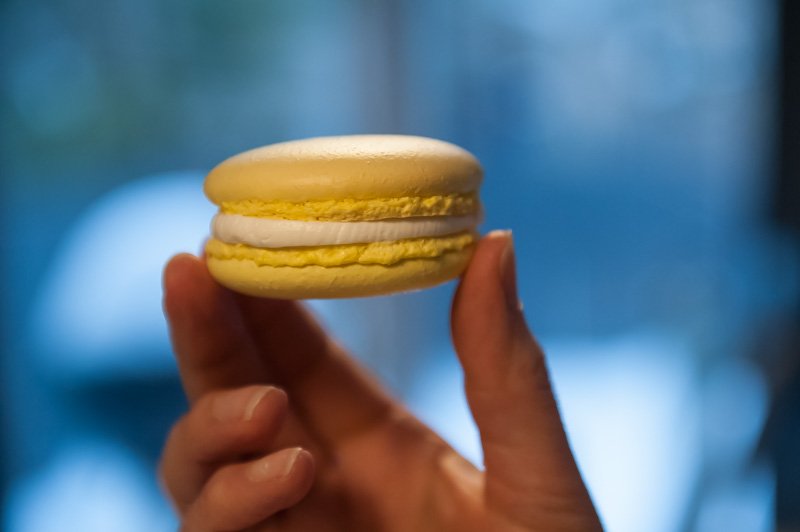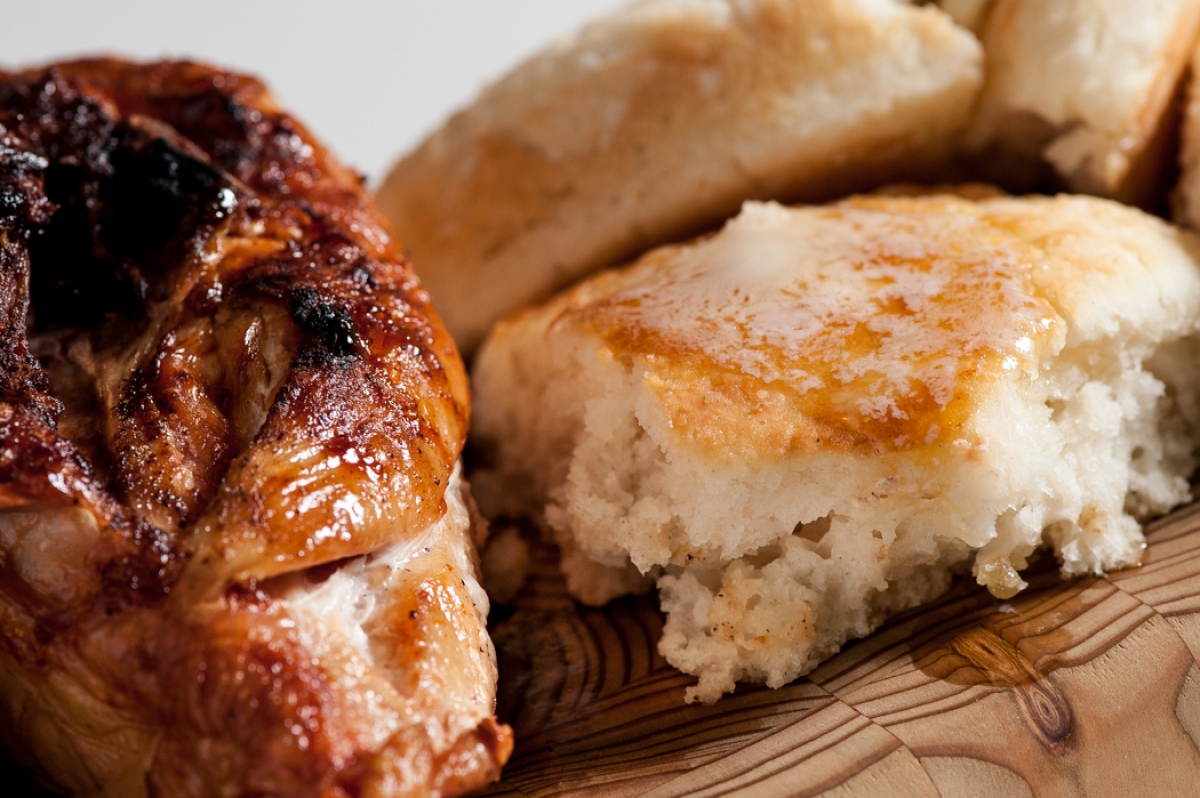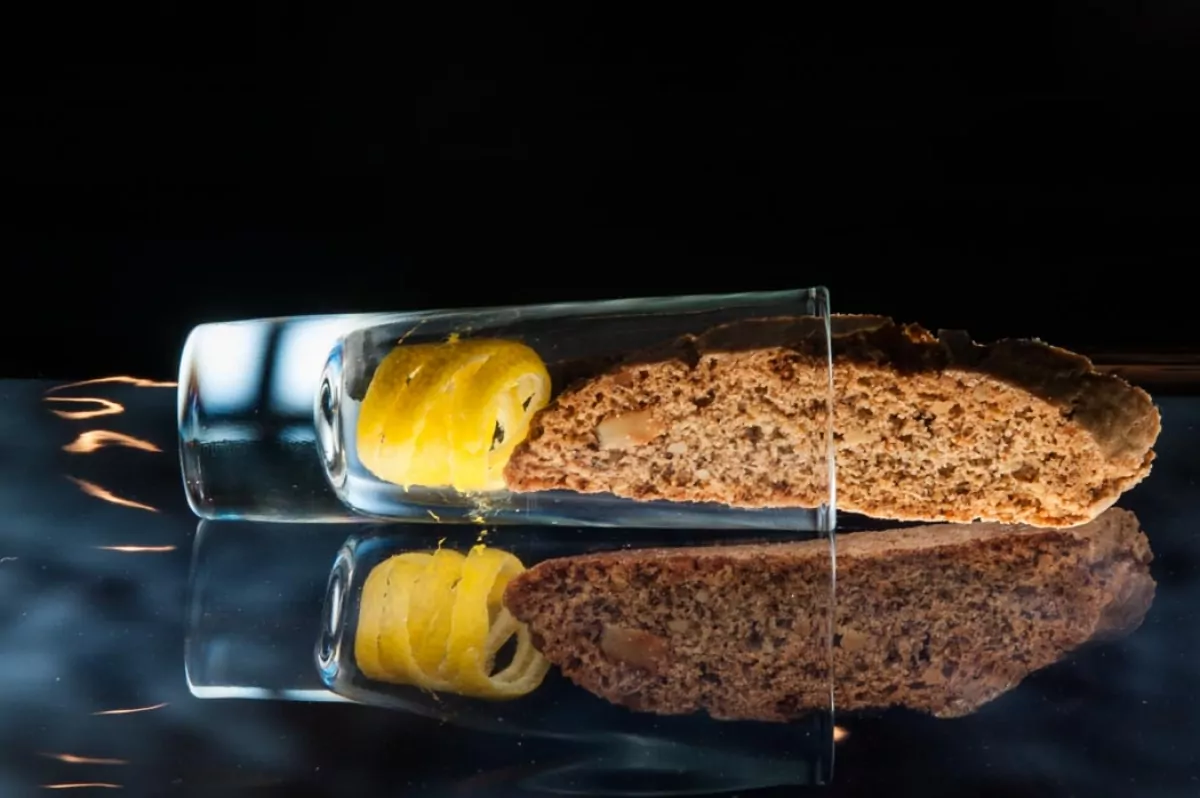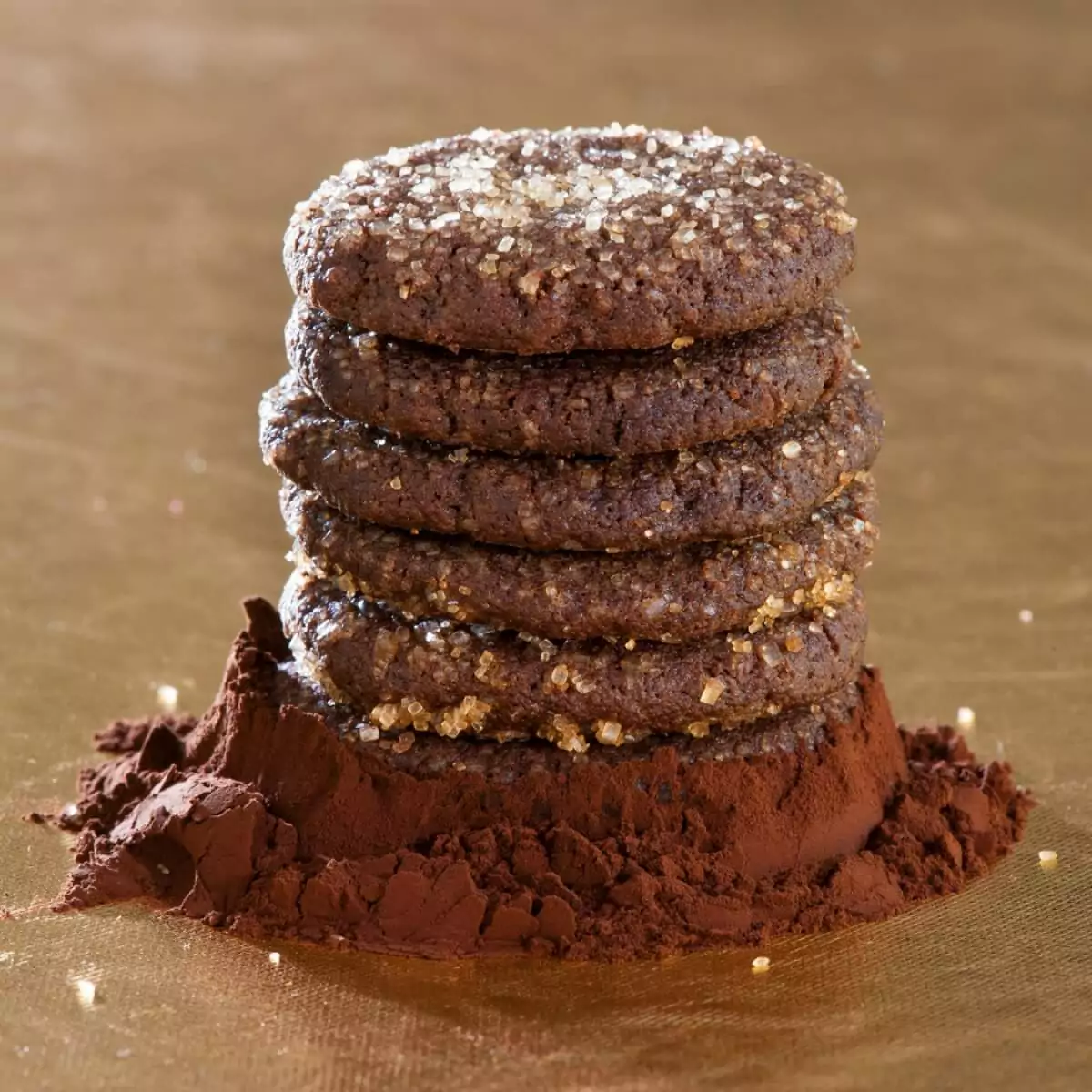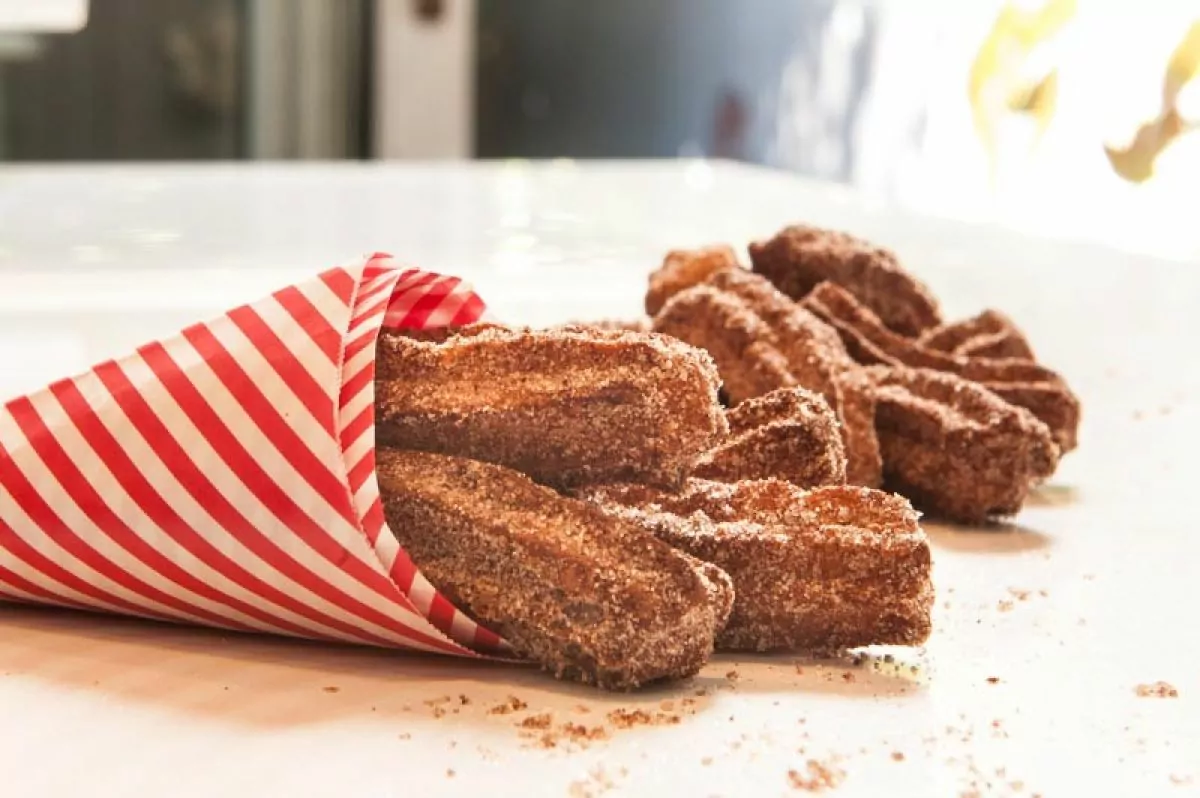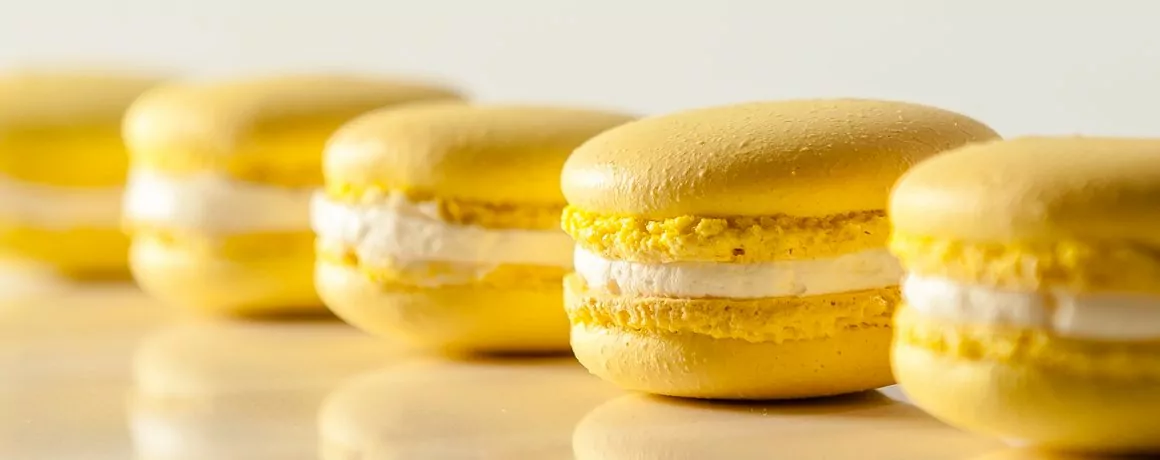
Lemon Macarons – Gluten-Free
January 26, 2016
Lemon Macaron includes very few ingredients: almond flour, eggs, lemon and butter. There is only one technique that you’ll need for successful macarons; when working with this meringue, you want to deflate the foam just enough so the macaron shell bakes smoothly, without cracking. Achieving the correct texture for the macaron batter requires a couple extra minutes so that the classic foot develops. The crackling creamy texture of a homemade macaron is the reward. Details below explain the steps for making these succulent cookies successful with every batch.
Please consult The Finer Cookie’s How-To post on how to whip egg whites for more details. This recipe has been adapted from Thomas Keller’s Bouchon Bakery. For further details on the reference, please see the end of this page.
The Finer Cookie is a participant in the Amazon Services LLC Associates Program, an affiliate advertising program designed to provide a means for websites to earn advertising fees by advertising and linking to amazon.com. This post contains affiliate links, which means The Finer Cookie will receive a small commission if you make a purchase using this link. This modest income helps support the website.
Ingredients
Macaron Ingredients
- 1 3/4 cups +2 1/2 tablespoons 212 grams 7.5 ounces almond flour
- 1 3/4 cups +2 1/2 tablespoons 212 grams 7.5 ounces powdered sugar
- 1/4 cup + 1 1/2 tablespoons 82 grams 2.9 ounces egg whites, room temperature
- 1/4 cup + 2 tablespoons 90 grams 3.17 ounces egg whites, room temperature
- 1 cup + 3 tablespoons 236 grams 8.32 ounces granulated sugar
- ⅔ cup 158 grams 5.57 ounces water
Lemon Curd Ingredients
- 1.8 grams silver leaf gelatin
- 108 grams eggs
- 108 grams granulated sugar
- 108 grams lemon juice
- 140 grams unsalted butter, room temperature
- 2 tablespoons 2 tablespoons 2 tablespoons grated lemon zest (about 2 lemons)
Buttercream Ingredients
- ¼ cups + 1 tablespoon 75 grams 2.6 ounces egg whites
- ¾ cup 150 grams 5.29 ounces granulated sugar
- 2 tablespoons + 2 ¼ teaspoons 33 grams 1 ounces granulated sugar
- 3 tablespoons + 1 teaspoon 42 grams 1.5 ounces water
- 2 sticks of 227 grams 8 ounces unsalted butter, at room temperature, cut into ½-inch cubes
- 1/4 cup 50 grams 1.75 ounces lemon curd

Instructions
OVEN SETTING AND TEMPERATURE
- I prefer to use the standard oven setting rather than convection because it is critical that the macarons do not brown; however, if you choose convection, set the temperature at 300F. If you have a standard oven, set the temperature at 325F.
SPECIAL COOKIE EQUIPMENT
- Large wide mouth bowl, accurate thermometer, large pastry bag with plain pastry tip 1/2 inch, small pastry bag, parchment paper, and 2.25″ plain cutter to draw circles on parchment paper, lemon yellow colour (liquid, gel or powder).
MIS-EN-PLACE FOR THE COOKIE
- Measure almond flour and powdered sugar in the bowl of a food processor and pulse to a very fine powder.
- Sift the flour/sugar mixture through a medium mesh sieve into the large wide bowl. If bits are too big for the sieve, run them through the food processor again until they pass. This step is important because it makes for an evenly textured macaron shell, and prevents lumpy shells.
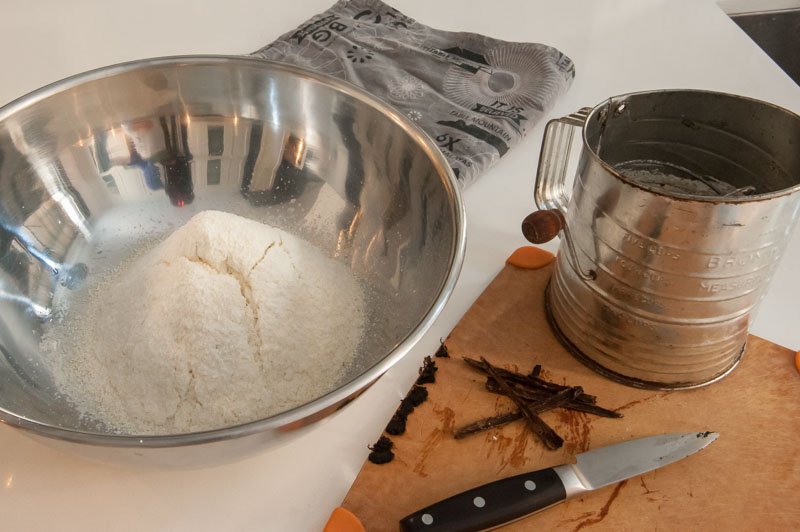
- Make a well in the center of the sifted mixture, leaving a layer of flour on the bottom of the bowl.
- Measure 90 grams of egg whites into the bowl of your stand mixer and 82 grams of egg whites into a separate bowl.
- To the bowl with 82 grams of egg whites, add lemon yellow food coloring. Make the color quite intense because it will have to colour the whole batter.
- In a small saucepan, measure sugar and water.
- Line the two trays with parchment. With the long edge facing you, draw 4 circles along the top edge of the paper, spacing them about an inch apart. For the second row, trace three circles spacing them between the first circles. Then trace 4 circles for the third row and 3 circles for the fourth row. You will have 14 circles in total on each sheet.
- Lightly spray the trays, flip the paper over (ink side down), and adhere the parchment. This will keep the parchment flat during baking.
- Alternately, I prefer thin baking sheets like Cookina. They transfer heat well and stop any sticking. Some people like silicone mats made just for macaron. Sometimes parchment doesn’t release fully and will cause the bottom of the shell to pucker.
- Measure the sugar and water in a small saucepan.
- Ready your thermometer.
- Ready your piping bag with 1/2 inch round tip.
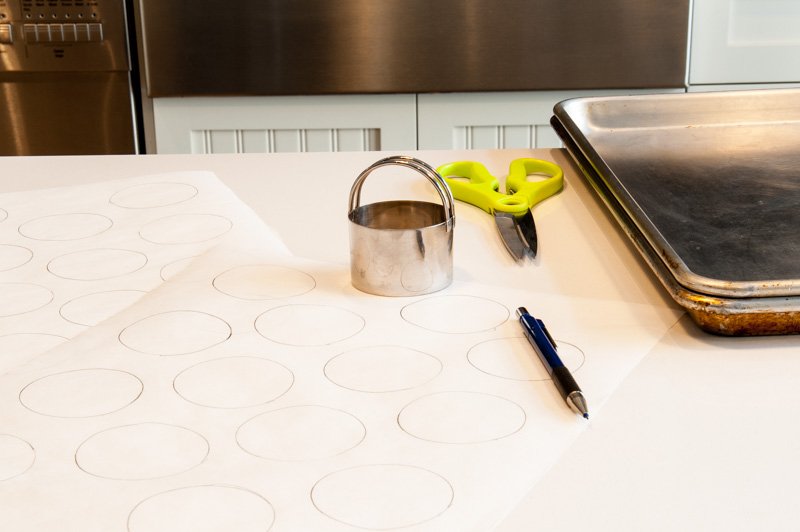
MAKING THE MERINGUE
- Turn the heat to low and stir to dissolve the sugar and water. Stir constantly until the mixture is clear and the sugar is no longer visible. Stop stirring and raise the heat.
- When the syrup has reached 203F degrees, reduce the heat.
- With the 90 grams of egg whites in the bowl of your stand mixer, set the speed to medium low, breaking up the mass of egg whites. Slowly increase the speed to medium high. Whip the egg whites to soft peaks.
- Return to the sugar syrup and increase the heat. Without stirring, heat the syrup to 248F degrees. As soon as it reaches temperature, turn the mixer on the Stir setting.
- Slowly pour the hot syrup between the whisk and the side of the bowl, being careful not to let the hot sugar touch the whisk. Once the meringue and the syrup are incorporated, increase the speed to medium-high. The egg whites will increase in volume and let off a lot of steam. Releasing steam is exactly what you want. Once the shells are in the oven, the excess steam could cause the shells to crack.
- Let the mixer run for approximately 5 minutes to cool the meringue. You can still add more lemon yellow food color at this point if you like.
- After 5 minutes, the bottom of the bowl will still be warm, but the meringue will be cool, not cold. Keep in mind, that as the sugar cools, the meringue will become stiffer. You want the meringue to remain flexible, and not stiff. The ideal temperature for this step is somewhere between 105F and 110F.
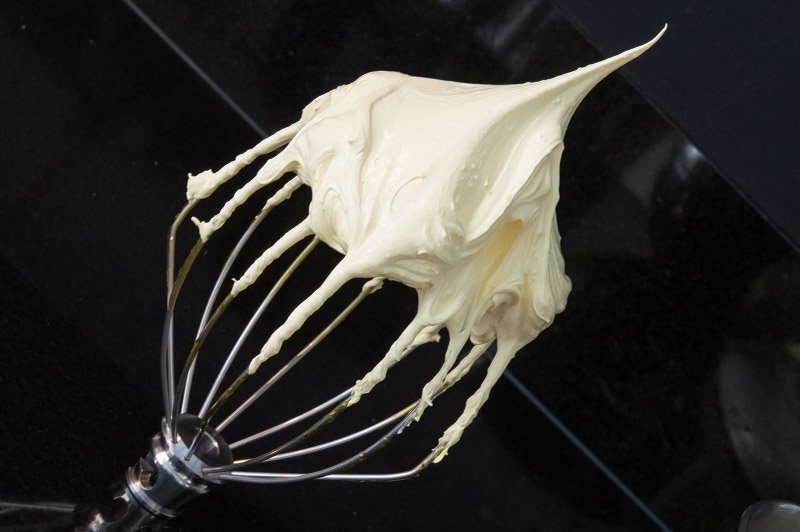
- While the meringue is cooling, pour 82 grams of egg whites into the large bowl with the flour/sugar mixture.
- Stir until all the dry ingredients are moistened and incorporated. The mixture will be very stiff, but this is the correct texture.
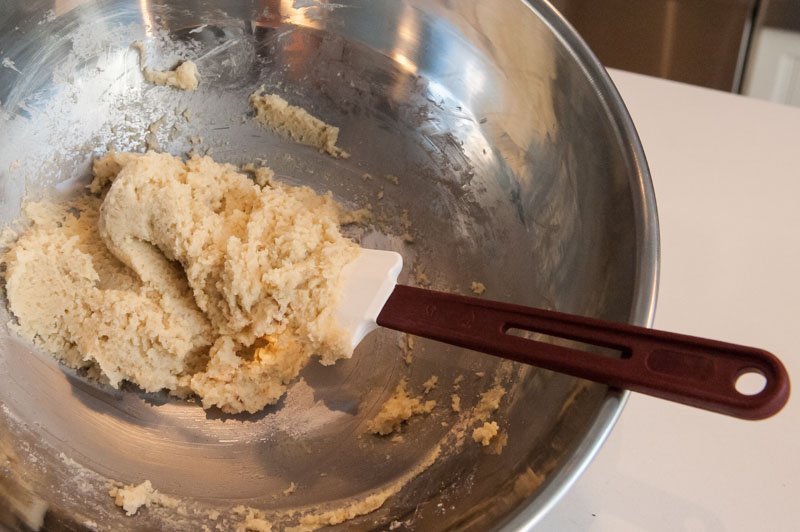
- Once the whipped meringue has cooled, add about one third to the almond/sugar paste and with a firm spatula, combine well so that the paste loosens. Be thorough at this stage. Don’t worry about deflating the meringue.
- Add meringue in three additions to the paste mixture.
- The next step is a make-or-break moment.
CRITICAL STEP FOR SUCCESSFUL MACARONS
- It is at this point, you want the meringue to deflate, be shiny, and pour off your spatula into thick ribbons that dissolve into itself very slowly. You are looking for a batter with a specific consistency that takes time to develop. As you fold the batter, it will deflate and loosen a little. This is what you want. You will be wondering: “Am I there yet?” If you’re asking, you’re probably not. The longer you fold the batter, the smoother it will become. As it loosens, it won’t hang on to your spatula. It will flow off your spatula in thick ribbons. Is the batter melting into itself? If not, keep folding You want the thick ribbons to slowly dissolve. Time yourself in one minute intervals. It usually takes me 3-4 minutes to get the right consistency. It is possible to go past the optimum texture. If you do, the batter will be a bit runny and liquefy. It won’t hold its ribbon and will melt into itself fast.
- Let the batter rest for a couple minutes. Look at it. See if it’s smooth and shiny. Ask if it has completely melted into itself. Remember what you see in the bowl, will be what you see on the tray.
- When properly mixed, the baked macarons will have a little foot on the bottom where the eggs have risen. Each foot should be the same thickness on each cookie.
UNDERSTANDING THE MACARON
- The loftier the egg white foam/meringue, the more rise you will get on the cookie and the more cracking will occur because of the rising. In other words, if you are making a soufflé, you want to keep the loft because you want the meringue to rise. When making macaron, you don’t want a lot of rise. Deflating the meringue will allow the shell to rise only a little without cracking or heaving. The finished shell will be on the thin side.
- The foot is formed by moisture. The foot is the escape route of the moisture as it bakes. One of the reasons the shell might crack in the oven is because there was too much moisture and it had to escape out the top. Don’t rush the cooling of the meringue before you fold.
PIPING THE SHELLS
- When you feel you’ve arrived at the right texture, fill a large pastry bag with the batter. The batter should still be thick so that it won’t run out the tip, and will be very easy to pipe.
- Holding the bag straight up and down, pipe enough batter to fill the inside of the circle. The batter will gentle spread the entire diameter of the circle and the nipple left by the tip will melt away. It’s important not to hold the bag off the side, because the cookie will bake unevenly.
- Keep count in your head as you pipe, and use the same count for each circle.
- Be careful not to pipe too much batter into each circle, or add more batter to those that don’t have enough.
- The finished cookie should be flat, thin and shiny.
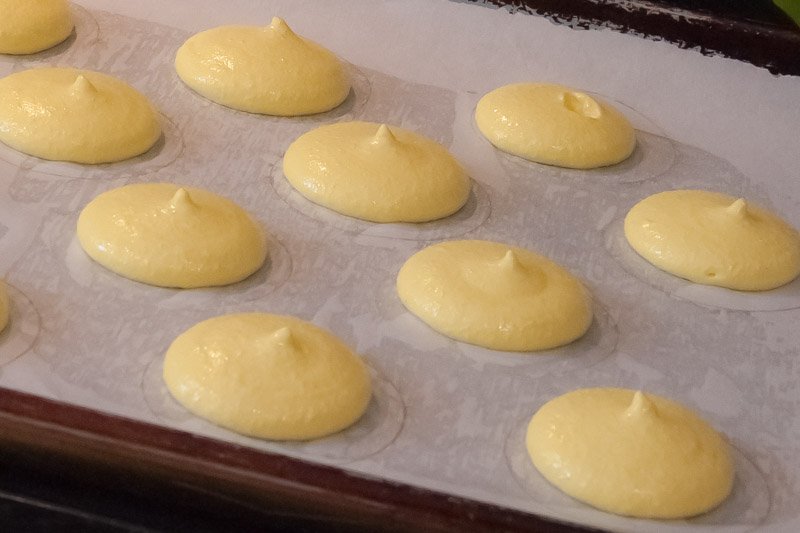
- Preheat the oven to 300F , but no hotter than 325F. If you’re using the convection setting, adjust the heat accordingly.
BAKE THE SHELLS
- After you pipe the shells, let them rest for at least 15 minutes. You will see the meringue settle out, become smoother and shinier, and the nipple left by the piping bag should melt away. It will also develop a dry skin, which will assist in developing the important foot. The dry skin will force the moisture out of the bottom, which gives the shell its coveted foot.
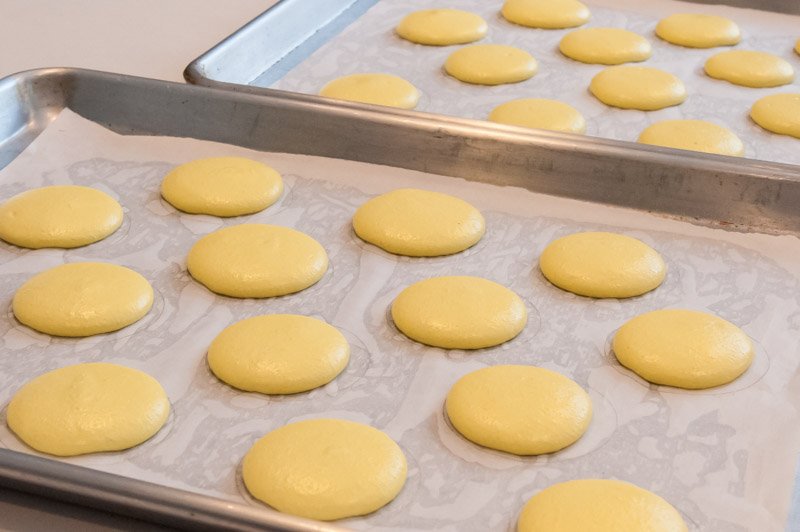
- Bake at 300F but no hotter than 325F for 8-15 minutes. Open and close the oven door twice during the cooking time to let the steam escape. Again, this helps keep the moisture at bay.
- When are they done? When the shell is dry to the touch. Remember it will continue to cook on the hot tray while cooling. If you’re unsure, with an offset spatula lift one and see if the bottom is fully formed. Be quick though so as not to let the temperature in the oven cool too much.
- Avoid the top rack as the temperature could be too hot. The macaron shells will crack if they are baked in an oven that’s too hot.
- Let trays cool on a wire rack, and then peel the cookies off the paper and let cool completely.
MIS-EN-PLACE FOR THE LEMON CURD
- Place the gelatin in a bowl of water to soften.
- Measure the eggs in a small saucepan and set aside.
- Measure the sugar and set aside.
- Grate the lemon and juice the remaining lemons.
- Measure and cut the butter into 1/2 inch cubes.
- Prepare the candy thermometer.
- Add the lemon juice to the sugar and place the pan over medium heat, stirring it constantly until dissolved.
MAKE THE CURD
- When ready, add the sugar to the eggs and whisk until smooth.
- Slowly add the lemon juice and place the pan on medium heat, stirring constantly until the mixture thickens and steam is visible on the surface.
- Stop cooking at this point so that the eggs don’t curdle. For those of you who are interested, eggs cook at 168-170 degrees F. The closer you can come to this temperature, the smoother the lemon curd will be.
- Remove the gelatin from the water and squeeze out the excess water.
- Then add it to the cooked egg mixture.
- Stir to dissolve.
- Strain the curd into a blender bowl.
- With the motor running, add the butter 2-3 cubes at a time.
- Let the curd cool to room temperature.
- At this point, the curd can be put in a piping bag to finish the Macaron, or refrigerated for up to 4 days. Place a piece of plastic wrap on the surface to prevent a skin from forming.
- If you are planning to use the refrigerated curd, bring it to room temperature and whisk vigorously until it is smooth and creamy.
MISE EN PLACE FOR THE BUTTERCREAM
- Measure butter and set aside to come to room temperature.
- Combine 150 grams of sugar and the water in a small saucepan.
- Measure 33 grams of sugar and set aside.
- Turn on the heat and stir constantly until the sugar is dissolved in the water and is no longer visible.
- Separate the egg whites and bring them to room temperature.
MAKING THE BUTTERCREAM
- Without stirring, cook the syrup to 203F degrees over medium high heat.
- While the syrup continues to cook, pour the warm egg whites into a bowl of a stand mixer and turn it to medium-low to break up the egg mass.
- Gradually add the 33 grams of sugar to the egg whites and continue whipping until they are beginning to form very loose peaks. If the whites are ready before the syrup, turn the mixer to Stir, just to keep them moving until the syrup is ready.
- When the syrup reaches 248F degrees, turn the mixer to medium-low speed and slowly add the hot syrup, pouring in between the bowl and the whisk. It’s best not to let the hot sugar hit the whisk because it will hit the sides of the bowl rather than go into the meringue.
- Increase the speed to medium-high and whisk for 15 minutes, or until the bottom of the bowl is room temperature and the whites hold a stiff peak. If the mixer bowl is too warm, then the butter will melt when added to the meringue. It’s very important that you allow the meringue enough time to cool.
- When the meringue is cool, reduce the speed to medium and slowly add the butter piece by piece, ensuring that it is incorporated after each addition. If at any point the mixture looks broken, increase the speed to re-emulsify it, then reduce it and continue to add the butter. Check the consistency. If it is too loose to hold its shape, refrigerate for 10-15 minutes, and beat again until it is the proper consistency.
- Add 50 grams of room temperature lemon curd to the finished buttercream.
FILL THE MACARON
- Fill one large bag with a 3/8 inch tip with the buttercream, and fill a smaller bag with a 1/4 inch tip with the lemon curd.
- Turn half of the cookies over.
- Holding the large bag at a slight angle, pipe the buttercream just inside the edge of the cookie, leaving the center empty.
- Repeat with the turned over cookies.
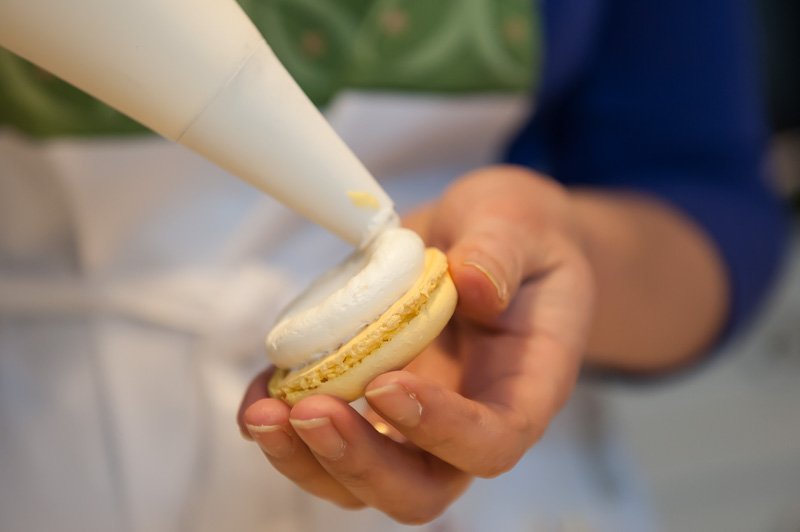
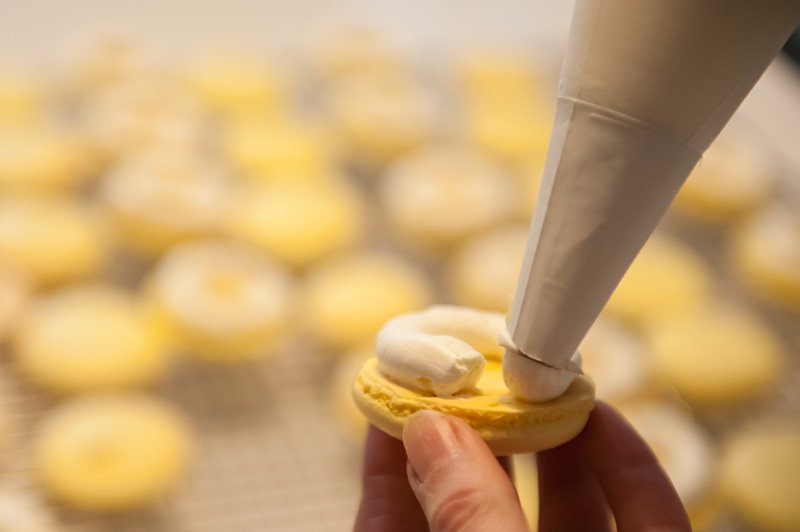
- Then fill the open center with lemon curd.
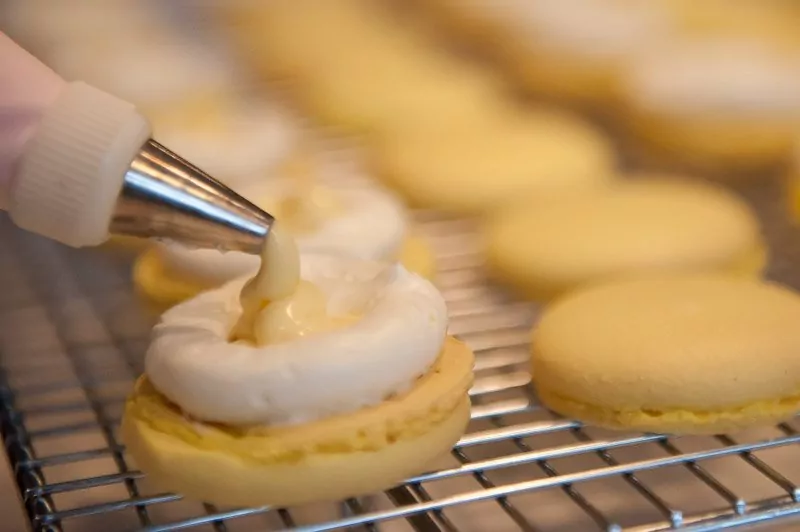
MAKING THE MACARON SANDWICHES
- Very carefully put the second cookie over the filling, twisting very gently. The risk here is that the cookie could crack as you are pressing them together.
- Twisting it slightly prevents cracking and evens out the filling.
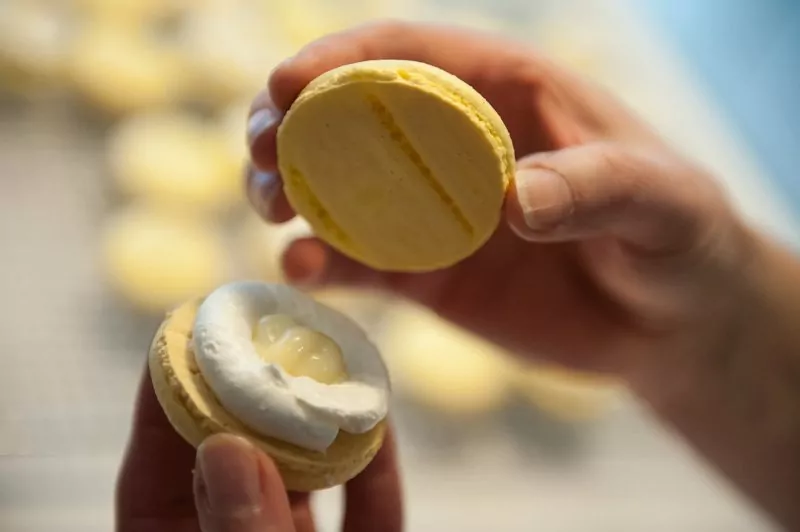
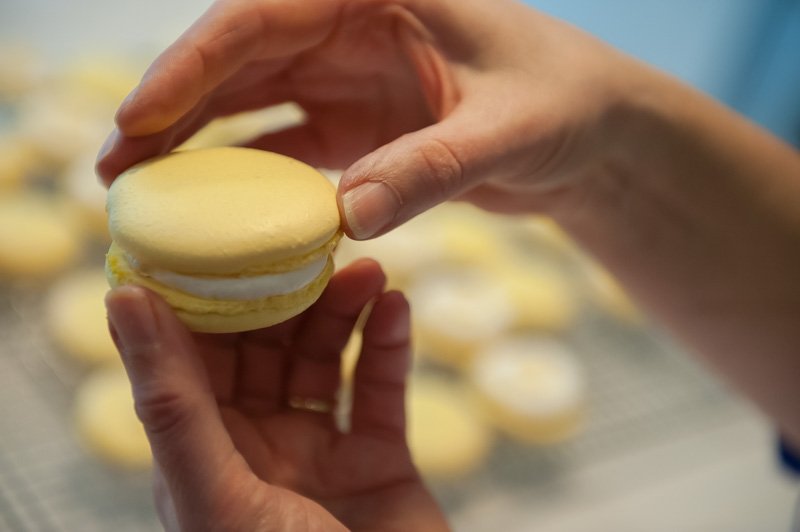
FLAVOUR MATURATION FOR THE MACARON
- The flavor at this point will be good, but will be better after sitting in the freezer for 24 hours. Before freezing, place the tray in the fridge for a few hours until the buttercream is firm. Then wrap each cookie individually in plastic, being careful not to crack the delicate macaron. Freeze for 24 hours or more. After a stint in the cold, the flavor will mature and reach its peak. Don’t let them sit too long, or you will lose the intensity of flavor.
